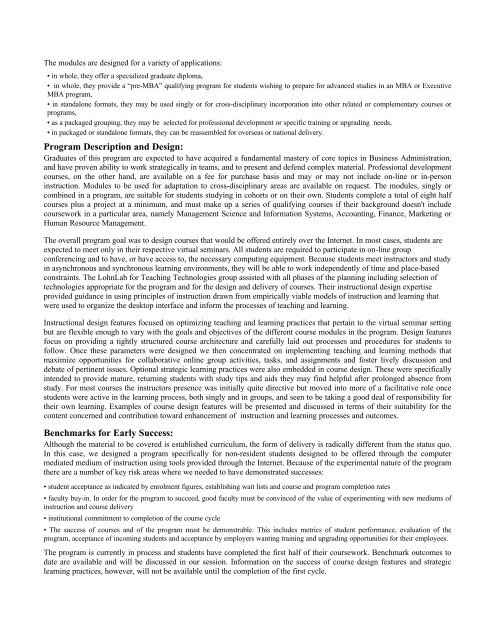ED-MEDIA 1999 Proceedings Book - Association for the ...
ED-MEDIA 1999 Proceedings Book - Association for the ...
ED-MEDIA 1999 Proceedings Book - Association for the ...
Create successful ePaper yourself
Turn your PDF publications into a flip-book with our unique Google optimized e-Paper software.
The modules are designed <strong>for</strong> a variety of applications:<br />
• in whole, <strong>the</strong>y offer a specialized graduate diploma,<br />
• in whole, <strong>the</strong>y provide a “pre-MBA” qualifying program <strong>for</strong> students wishing to prepare <strong>for</strong> advanced studies in an MBA or Executive<br />
MBA program,<br />
• in standalone <strong>for</strong>mats, <strong>the</strong>y may be used singly or <strong>for</strong> cross-disciplinary incorporation into o<strong>the</strong>r related or complementary courses or<br />
programs,<br />
• as a packaged grouping, <strong>the</strong>y may be selected <strong>for</strong> professional development or specific training or upgrading needs,<br />
• in packaged or standalone <strong>for</strong>mats, <strong>the</strong>y can be reassembled <strong>for</strong> overseas or national delivery.<br />
Program Description and Design:<br />
Graduates of this program are expected to have acquired a fundamental mastery of core topics in Business Administration,<br />
and have proven ability to work strategically in teams, and to present and defend complex material. Professional development<br />
courses, on <strong>the</strong> o<strong>the</strong>r hand, are available on a fee <strong>for</strong> purchase basis and may or may not include on-line or in-person<br />
instruction. Modules to be used <strong>for</strong> adaptation to cross-disciplinary areas are available on request. The modules, singly or<br />
combined in a program, are suitable <strong>for</strong> students studying in cohorts or on <strong>the</strong>ir own. Students complete a total of eight half<br />
courses plus a project at a minimum, and must make up a series of qualifying courses if <strong>the</strong>ir background doesn't include<br />
coursework in a particular area, namely Management Science and In<strong>for</strong>mation Systems, Accounting, Finance, Marketing or<br />
Human Resource Management.<br />
The overall program goal was to design courses that would be offered entirely over <strong>the</strong> Internet. In most cases, students are<br />
expected to meet only in <strong>the</strong>ir respective virtual seminars. All students are required to participate in on-line group<br />
conferencing and to have, or have access to, <strong>the</strong> necessary computing equipment. Because students meet instructors and study<br />
in asynchronous and synchronous learning environments, <strong>the</strong>y will be able to work independently of time and place-based<br />
constraints. The LohnLab <strong>for</strong> Teaching Technologies group assisted with all phases of <strong>the</strong> planning including selection of<br />
technologies appropriate <strong>for</strong> <strong>the</strong> program and <strong>for</strong> <strong>the</strong> design and delivery of courses. Their instructional design expertise<br />
provided guidance in using principles of instruction drawn from empirically viable models of instruction and learning that<br />
were used to organize <strong>the</strong> desktop interface and in<strong>for</strong>m <strong>the</strong> processes of teaching and learning.<br />
Instructional design features focused on optimizing teaching and learning practices that pertain to <strong>the</strong> virtual seminar setting<br />
but are flexible enough to vary with <strong>the</strong> goals and objectives of <strong>the</strong> different course modules in <strong>the</strong> program. Design features<br />
focus on providing a tightly structured course architecture and carefully laid out processes and procedures <strong>for</strong> students to<br />
follow. Once <strong>the</strong>se parameters were designed we <strong>the</strong>n concentrated on implementing teaching and learning methods that<br />
maximize opportunities <strong>for</strong> collaborative online group activities, tasks, and assignments and foster lively discussion and<br />
debate of pertinent issues. Optional strategic learning practices were also embedded in course design. These were specifically<br />
intended to provide mature, returning students with study tips and aids <strong>the</strong>y may find helpful after prolonged absence from<br />
study. For most courses <strong>the</strong> instructors presence was initially quite directive but moved into more of a facilitative role once<br />
students were active in <strong>the</strong> learning process, both singly and in groups, and seen to be taking a good deal of responsibility <strong>for</strong><br />
<strong>the</strong>ir own learning. Examples of course design features will be presented and discussed in terms of <strong>the</strong>ir suitability <strong>for</strong> <strong>the</strong><br />
content concerned and contribution toward enhancement of instruction and learning processes and outcomes.<br />
Benchmarks <strong>for</strong> Early Success:<br />
Although <strong>the</strong> material to be covered is established curriculum, <strong>the</strong> <strong>for</strong>m of delivery is radically different from <strong>the</strong> status quo.<br />
In this case, we designed a program specifically <strong>for</strong> non-resident students designed to be offered through <strong>the</strong> computer<br />
mediated medium of instruction using tools provided through <strong>the</strong> Internet. Because of <strong>the</strong> experimental nature of <strong>the</strong> program<br />
<strong>the</strong>re are a number of key risk areas where we needed to have demonstrated successes:<br />
• student acceptance as indicated by enrolment figures, establishing wait lists and course and program completion rates<br />
• faculty buy-in. In order <strong>for</strong> <strong>the</strong> program to succeed, good faculty must be convinced of <strong>the</strong> value of experimenting with new mediums of<br />
instruction and course delivery<br />
• institutional commitment to completion of <strong>the</strong> course cycle<br />
• The success of courses and of <strong>the</strong> program must be demonstrable. This includes metrics of student per<strong>for</strong>mance, evaluation of <strong>the</strong><br />
program, acceptance of incoming students and acceptance by employers wanting training and upgrading opportunities <strong>for</strong> <strong>the</strong>ir employees.<br />
The program is currently in process and students have completed <strong>the</strong> first half of <strong>the</strong>ir coursework. Benchmark outcomes to<br />
date are available and will be discussed in our session. In<strong>for</strong>mation on <strong>the</strong> success of course design features and strategic<br />
learning practices, however, will not be available until <strong>the</strong> completion of <strong>the</strong> first cycle.
















